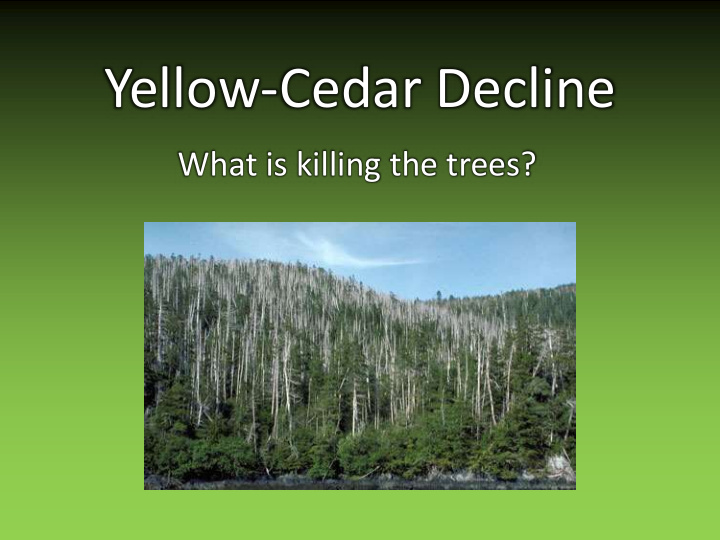



Yellow-Cedar Decline What is killing the trees?
Yellow-Cedar Researchers • Tara Barrett – U.S. Forest Service, Wenatchee, WA • Allison Bidlack – Alaska Coastal Rainforest Center, UAS, Juneau, AK • Sarah Bisbing – University of Nevada Reno, Reno, NV • Brian Buma – Dept. of Natural Resource, UAS, Juneau, AK • Vanessa Comeau – University of British Columbia, Vancouver, BC • Rich Cronn – U.S. Forest Service, Corvallis, OR • Dave D’Amore – U.S. Forest Service, Juneau, AK • Paul Hennon – U.S. Forest Service (retired) • John Krapek – Northern Arizona University, Flagstaff, AZ • Robin Mulvey – U.S. Forest Service, Juneau, AK • Lauren Oakes – Earth System Science, Stanford University, Stanford, CA • Nick Reynolds – Council of the Haida Nation, Haida Gwaii, BC • Sari Saunders – B.C. Ministry of Forests, Lands, & Nat. Res., Victoria, BC • Sheila Spores – U. S. Forest Service, Sitka, AK • Dustin Wittwer – U. S. Forest Service, Juneau, AK Apologies if I missed anyone!
Yellow-Cedar Ecology • Slow growing • Long lived (up to 1,000 years) • Limited reproduction • Not very competitive • Grows best on moderately well drained soil • Mostly found on shallow soils where competition is low • Fine roots in upper soil horizon for nutrient uptake • Roots are less cold hardy than other species and deharden at lower temperature
• High concentrations of bioactive chemicals in foliage and wood • Give characteristic color and odor • Also highly rot resistant • Dead trees remain standing up to 80 years
Yellow-Cedar Range & Extent of Decline • Coastal rainforest • Mostly BC and SE Alaska • Extends to northern CA • Disjunct populations in PWS From Buma et al. 2016 (Global Change Biology , doi: 10.111/gcb 13555)
Early Research USDA Forest Service Why? Bears? Bark beetles? USDA Forest Service USDA Forest Service USDA Forest Service Fungal infections?
Lessons Learned • Problem is specific to yellow-cedar • Mortality starts with fine roots • Decline began in 1880-1900, increased in late 1990s • Trees on poorly drained soils are most affected • Direct cause appears to be abiotic
Abiotic Factors • Aluminum toxicity • Calcium deficiency • Soil acidity • Freezing injury
It’s complicated… • Climate warming • Shift from snow to rain • No snowpack in late winter • Frequency of cold Shutterstock spells unchanged Pixabay/Creative Commons • Freezing damage to fine roots • Tree mortality (may take several events) 25.media.tumblr.com
Additional Factors • Deer browsing may limit regeneration where densities are high • Regeneration potential is generally low, and may be Deby Dixon/Flickr more limited in post- decline stands • Harvest may affect overall species population lh2treeid@blogspot.cocm alaska-in-pictures.com
What about the future? • Areas of decline are expanding • Regeneration likely limited in post-decline stands • What about migration? • Management options (harvesting, planting?) • Climate modeling is key, but has limitations
Recommend
More recommend